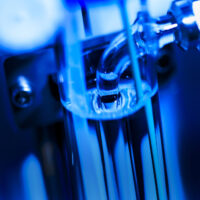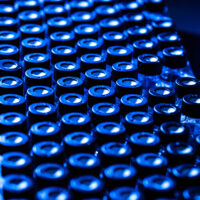
What has low toxicity and is essential to manufacturing active pharmaceutical ingredients? Introducing DAIB, a hypervalent iodine compound

【CAS No.】3240-34-4
【Chemical name】(Diacetoxyiodo)benzene
【Chemical formula】C10H11IO4
Active pharmaceutical ingredients (APIs) are synthesized through a wide range of chemical reactions. The hypervalent iodine compound (diacetoxyiodo)benzene (DAIB), manufactured by MANAC, plays a key role as a reagent known as an “oxidant” in this synthesis process.
“Hypervalent iodine compound” is a term with which many may be unfamiliar. Just what kind of properties do these compounds have? And why is DAIB used to manufacture APIs? DAIB features great advantages over traditional oxidants, and this article dives into the secrets behind them.
■ What you can learn from this article ✔ Hypervalent iodine compounds are suitable for the synthesis of active pharmaceutical ingredients (APIs) due to their low toxicity and high safety. ✔ DAIB has the simplest structure among hypervalent iodine compounds and is widely used as an oxidant. ✔ While the production of DAIB involves high costs and the issue of byproducts (iodobenzene), MANAC is working on reducing manufacturing costs and developing technologies for recycling the byproducts. ■ Recommended Articles ・ Aiming to provide high-quality products at a low cost / Taking on the ardent challenge of reducing the manufacturing costs of DAIB, a hypervalent iodine compound (1) ・ Turning the tide just when all hope seemed lost / Taking on the immense challenge of reducing the manufacturing costs of DAIB, a hypervalent iodine compound (2)
contents
Introducing hypervalent iodine compounds
A hypervalent iodine compound is just that — an iodine compound that is hypervalent. “Iodine compound” here indicates a compound that contains an iodine (I) atom. What, then, does “hypervalent” mean?
Let us first go over the concept of valence. Valence expresses what can be described as the number of “hands” a specific atom has, which corresponds with the number of bonds it can form with other atoms. The valence of iodine atoms is normally one. For example, hydrogen iodide (HI) is formed by a single bond between an iodine atom and a hydrogen atom.

A hypervalent state is one in which the most outer electron shell (the part of the atom related to its bonds to other atoms), which sits furthest from the atom’s nucleus, bears more than eight electrons. This state enables the atom to form even more bonds with other atoms. For example, a hypervalent iodine atom can bond with multiple atoms at once, as illustrated below. Compounds that contain iodine atoms in a hypervalent state are “hypervalent iodine compounds.”

Hypervalent iodine compounds feature several advantages. They are generally stable compounds with low volatility, making them easy to handle. With their high reactivity, hypervalent iodine compounds can also be used to carry out reactions that are typically difficult to conduct. Furthermore, hypervalent iodine compounds are environmentally friendly as they exhibit nearly zero toxicity.
DAIB: The most fundamental hypervalent iodine compound
MANAC manufactures and markets DAIB, a type of hypervalent iodine compound. As indicated above, DAIB is an abbreviation for (diacetoxyiodo)benzene. The compound is also known as iodobenzene diacetate and phenyliodine diacetate (PIDA). DAIB has the simplest hypervalent iodine compound structure, comprising an iodine atom bonded with one benzene ring and two acetyl groups (-OCOCH3). It shares the same properties and reactivity as other general hypervalent iodine compounds.

A low-toxic, environmentally friendly oxidant perfect for manufacturing APIs
DAIB and other hypervalent iodine compounds are often used as oxidants. Oxidants are reagents used to oxidize other substances.
There exists a myriad of oxidants outside hypervalent iodine compounds. However, hypervalent iodine compounds, such as DAIB, are the most suitable for producing APIs. Exactly why is this the case?
Traditional oxidants usually contain heavy metals such as lead and mercury. However, heavy-metal-based oxidants are highly toxic and therefore challenging to use in synthesizing compounds requiring high safety, such as APIs.
In this regard, iodine is a highly safe substance used in mouthwash and disinfectant solutions. This high level of safety allows for DAIB and other hypervalent iodine compounds to readily be used as low-toxic, environmentally friendly oxidants in API syntheses. Hypervalent iodine compounds are also advantageous in that they exhibit the same reactivity as heavy-metal-based oxidants.
There are, however, certain drawbacks to hypervalent iodine compounds.
One issue is the high cost of manufacturing. The production of hypervalent iodine compounds requires many processes, resulting in manufacturing costs several times that of heavy-metal-based oxidants.
Another issue is the occurrence of byproducts. For example, after DAIB functions as an oxidant, iodobenzene is generated as a byproduct. This iodobenzene must be removed by any of the available methods in order to raise the purity of the targeted product.
Despite these drawbacks, hypervalent iodine compounds remain outstanding oxidants that can achieve low toxicity, high safety, and efficiency all at once. Hypervalent iodine compounds will be essential reagents for realizing “green chemistry” (environmentally friendly synthetic chemistry), a key concept in modern chemistry.
Overcoming DAIB’s drawbacks with MANAC’s technologies!
MANAC has tirelessly explored ways to overcome the drawbacks of hypervalent iodine compounds, including their high manufacturing costs and the occurrence of byproducts.
Through these efforts, we have succeeded in reducing the manufacturing costs of the DAIB hypervalent compound marketed by MANAC. In addition, we are also exploring technologies to recycle the iodobenzene byproduct that occurs following DAIB production.
There is a defined global market for DAIB, and applications outside its use as an oxidant are expected to expand. MANAC will continue to strive in its manufacture and marketing of DAIB.













